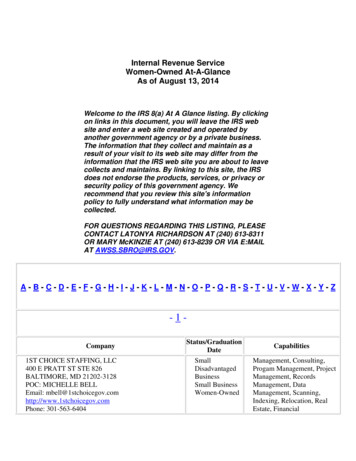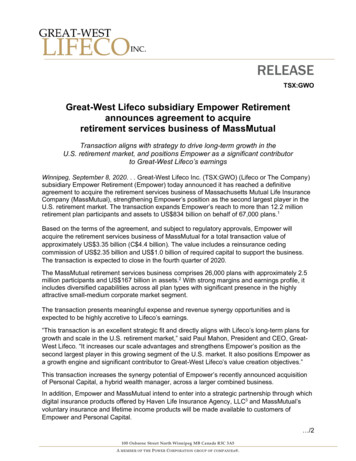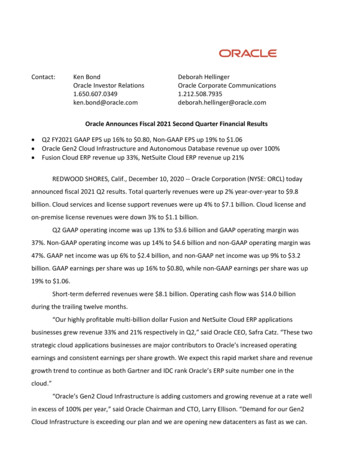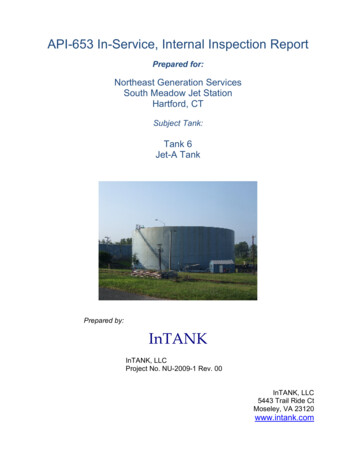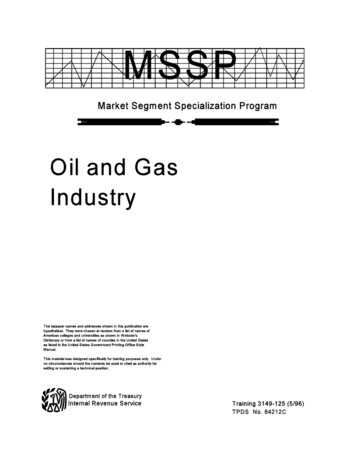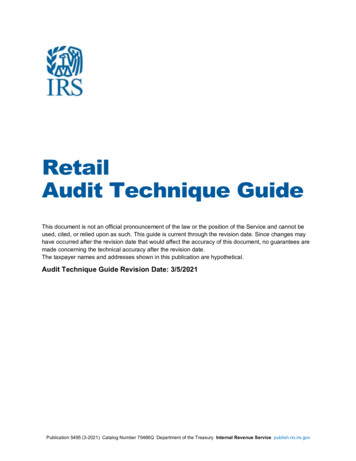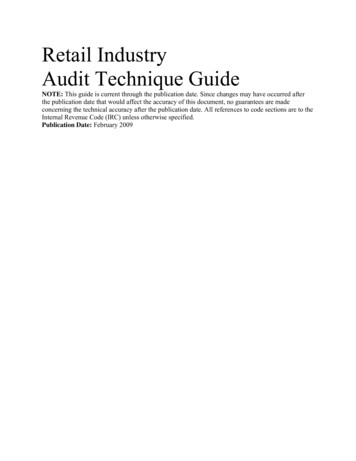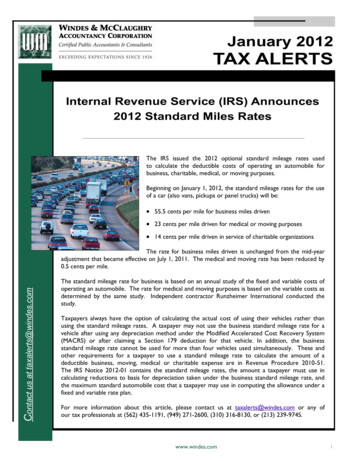
Transcription
January 2012TAX ALERTSInternal Revenue Service (IRS) Announces2012 Standard Miles RatesThe IRS issued the 2012 optional standard mileage rates usedto calculate the deductible costs of operating an automobile forbusiness, charitable, medical, or moving purposes.Beginning on January 1, 2012, the standard mileage rates for the useof a car (also vans, pickups or panel trucks) will be: 55.5 cents per mile for business miles driven 23 cents per mile driven for medical or moving purposes 14 cents per mile driven in service of charitable organizationsContact us at taxalerts@windes.comThe rate for business miles driven is unchanged from the mid-yearadjustment that became effective on July 1, 2011. The medical and moving rate has been reduced by0.5 cents per mile.The standard mileage rate for business is based on an annual study of the fixed and variable costs ofoperating an automobile. The rate for medical and moving purposes is based on the variable costs asdetermined by the same study. Independent contractor Runzheimer International conducted thestudy.Taxpayers always have the option of calculating the actual cost of using their vehicles rather thanusing the standard mileage rates. A taxpayer may not use the business standard mileage rate for avehicle after using any depreciation method under the Modified Accelerated Cost Recovery System(MACRS) or after claiming a Section 179 deduction for that vehicle. In addition, the businessstandard mileage rate cannot be used for more than four vehicles used simultaneously. These andother requirements for a taxpayer to use a standard mileage rate to calculate the amount of adeductible business, moving, medical or charitable expense are in Revenue Procedure 2010-51.The IRS Notice 2012-01 contains the standard mileage rates, the amount a taxpayer must use incalculating reductions to basis for depreciation taken under the business standard mileage rate, andthe maximum standard automobile cost that a taxpayer may use in computing the allowance under afixed and variable rate plan.For more information about this article, please contact us at taxalerts@windes.com or any ofour tax professionals at (562) 435-1191, (949) 271-2600, (310) 316-8130, or (213) 239-9745.www.windes.com1
Payroll Tax Cut Extended TemporarilyOn December 23, Congress passed, and President Obama signedinto law, the “Temporary Payroll Tax Cut Continuation Act of2011” (the TTCA, P.L. 112-78). The tax provisions of the TTCAconsist of a two-month temporary extension of the payroll taxcut that is in place for 2011, plus a parallel extension of a lowerSelf-Employment Contributions Act (SECA) tax rate on selfemployment income. In a related news release, the IRS alsoprovided guidance to employers on how and when to implementthe new rate.OverviewThe Federal Insurance Contributions Act (FICA) imposes two taxes on employers, employees, andself-employed workers—one for Old Age, Survivors and Disability Insurance (OASDI, commonlyknown as the Social Security tax); and the other for Hospital Insurance (HI, commonly known as theMedicare tax). Before passage of the Tax Relief, Unemployment Insurance Reauthorization, and JobCreation Act of 2010 (the 2010 Tax Relief Act, P.L. 111-312), the FICA tax rate for employees andemployers was 7.65% each—6.2% for OASDI and 1.45% for HI. Under the SECA tax, selfemployment income of self-employed taxpayers was subject to a tax of 15.3%—12.4% for OASDIand 2.9% for HI. There is a maximum amount of compensation subject to the OASDI tax (the wagebase), but no maximum for HI. (The wage base is 106,800 for 2011 and 110,100 for 2012.) Similarrules apply under the Railroad Retirement Tax Act (RRTA).Contact us at taxalerts@windes.comUnder pre-2010 Tax Relief Act law, for computing the income tax of an individual, an above-the-linededuction is allowed equal to 50% of the amount of the SECA tax imposed on the individual's selfemployment income for the tax year.Under Code Sec. 1402(a)(12), a taxpayer is allowed a deduction in computing net earnings from selfemployment equal to: (1) net earnings from self-employment as determined before taking the CodeSec. 1402(a)(12) deduction into account, multiplied by (2) one-half the sum of the OASDI tax rateand the HI tax rate. This deduction is allowed in computing net earnings from self-employment inlieu of the above-the-line deduction on 50% of the self-employment tax. Thus, the above-the-linededuction cannot be taken in computing self-employment tax liability. The Code Sec. 1402(a)(12)deduction is designed to put the self-employed in the same position as employees in that they don'thave to pay self-employment tax on about half of the amount of the tax itself.Temporary Tax Cut for 2011For remuneration received during 2011, the 2010 Tax Relief Act reduced the employee OASDI taxrate under the FICA tax by two percentage points to 4.2%. Similarly, for self-employment incomefor tax years beginning in 2011, the Act reduced the OASDI tax rate under the SECA tax by twopercentage points to 10.4%. As a result, for 2011, employees pay only 4.2% Social Security tax onwages up to 106,800 and self-employed individuals pay only 10.4% Social Security self-employmenttaxes on self-employment income up to 106,800. The 2010 Tax Relief Act provided rules forcoordination with deductions for employment taxes, as follows:2
Payroll Tax Cut Extended Temporarily (continued)The 50% of SECA tax deduction allowed for tax years beginning in 2011 is computed at the rate of59.6% of the OASDI tax paid, plus one-half of the HI tax paid. A new percentage (59.6%) replacesthe rate of one-half (50%) allowed under pre-2010 Tax Relief Act law for this portion of thededuction. The new percentage is necessary to continue to allow the self-employed taxpayer todeduct the full amount of the employer portion of SECA taxes. The employer OASDI tax rateremains at 6.2%, while the employee portion falls to 4.2%. Thus, the employer share of total OASDItaxes is 6.2% divided by 10.4%, or 59.6% of the OASDI portion of SECA taxes. However, the twopercentage-point reduction is not taken into account in determining the Code Sec. 1402 SECA taxdeduction allowed for determining the amount of the net earnings from self employment for the taxyear.New LawContact us at taxalerts@windes.comUnder the TTCA, the reduced employee OASDI tax rate of 4.2% under the FICA tax, and theequivalent employee portion of the RRTA tax, are extended to apply to covered wages paid in thefirst two months of 2012. The TTCA also provides for a recapture of any benefit a taxpayer mayhave received from the reduction in the OASDI tax rate, and the equivalent employee portion of theRRTA tax, for remuneration received during the first two months of 2012 in excess of 18,350 (i.e.,two-twelfths of the 2012 wage base of 110,100). The recapture is accomplished by a tax equal to2% of the amount of wages (and railroad compensation) received during the first two months of2012 that exceed 18,350.For tax years beginning in 2012, the TTCA provides that the OASDI rate for a self-employedindividual remains at 10.4%, for self-employment income of up to 18,350 (reduced by wages subjectto the lower OASDI rate for 2012). Related rules for 2011 concerning coordination of a selfemployed individual's deductions in determining net earnings from self-employment and income taxalso apply for 2012, except that the income tax deduction allowed for the OASDI portion of SECAtax paid for tax years beginning in 2012 is computed at the rate of 59.6% of the OASDI tax paid onself-employment income of up to 18,350. For self-employment income in excess of this amount,the deduction is equal to half of the OASDI portion of the SECA tax paid. The Joint Committee onTaxation’s explanation of the TTCA says that the 59.6% used for the first 18,350 of selfemployment income is necessary to continue to allow the self-employed taxpayer to deduct the fullamount of the employer portion of SECA taxes. The employer OASDI tax rate remains at 6.2%,while the employee portion falls to a 4.2% rate for the first 18,350 of self-employment income.Thus, the employer share of total OASDI taxes is 6.2% divided by 10.4%, or 59.6% of the OASDIportion of SECA taxes, for the first 18,350 of self-employment income.Guidance to EmployersThe IRS instructed employers to implement the new payroll tax rate as soon as possible in 2012, butnot later than January 31, 2012. If there is any Social Security tax over-withheld during January,employers should make an offsetting adjustment in workers' pay as soon as possible, but notlater than March 31, 2012. Further guidance will be issued by the IRS as necessary to implement theprovisions of the two-month extension, including the issuance of revised employment tax forms andinstructions and information for employees who may be subject to the new recapture provision. Formost employers, the quarterly employment tax return for the quarter ending March 31, 2012 is dueApril 30, 2012.For more information about this article, please contact us at taxalerts@windes.com or any ofour tax professionals at (562) 435-1191, (949) 271-2600, (310) 316-8130, or (213) 239-9745.3
Plan Now to Get Full Benefit ofSaver’s Tax CreditLow- and moderate-income workers can take steps now to save forretirement and earn a special tax credit in 2011 and the years ahead,according to the Internal Revenue Service (IRS).The saver’s credit helps offset part of the first 2,000 workers voluntarilycontribute to IRAs and to 401(k) plans and similar workplace retirementprograms. Also known as the retirement savings contributions credit,the saver’s credit is available in addition to any other tax savings thatapply. Eligible workers still have time to make qualifying retirementcontributions and get the saver’s credit on their 2011 tax returns. Peoplehave until April 17, 2012 to set up a new individual retirement arrangement or add money to an existing IRA and still get credit for 2011.However, elective deferrals must be made by the end of the year to a401(k) plan or similar workplace program, such as a 403(b) plan foremployees of public schools and certain tax-exempt organizations, agovernmental 457 plan for state or local government employees, and the Thrift Savings Plan forfederal employees. Employees who are unable to set aside money for this year may want toschedule their 2012 contributions soon so their employers can begin withholding them in January.Contact us at taxalerts@windes.comThe saver’s credit can be claimed by: Married couples filing jointly with incomes up to 56,500 in 2011 or 57,500 in 2012; Heads of Household with incomes up to 42,375 in 2011 or 43,125 in 2012; and Married individuals filing separately and singles with incomes up to 28,250 in 2011or 28,750 in 2012.Like other tax credits, the saver’s credit can increase a taxpayer’s refund or reduce the tax owed.Though the maximum saver’s credit is 1,000, 2,000 for married couples, the IRS cautioned thatit is often much less and, due in part to the impact of other deductions and credits, may, in fact, bezero for some taxpayers.A taxpayer’s credit amount is based on his or her filing status, adjusted gross income, tax liabilityand amount contributed to qualifying retirement programs. Form 8880 is used to claim the saver’scredit, and its instructions have details on figuring the credit correctly. In tax year 2009, the mostrecent year for which complete figures are available, saver’s credits totaling just over 1 billion wereclaimed on just over 6.25 million individual income tax returns. Saver’s credits claimed on thesereturns averaged 202 for joint filers, 159 for heads of household, and 121 for single filers.The saver’s credit supplements other tax benefits available to people who set money aside forretirement. For example, most workers may deduct their contributions to a traditional IRA. ThoughRoth IRA contributions are not deductible, qualifying withdrawals, usually after retirement, are taxfree. Normally, contributions to 401(k) and similar workplace plans are not taxed until withdrawn.4
Plan Now to Get Full Benefit of Saver’s Tax Credit (continued)Other special rules that apply to the saver’s credit include the following: Eligible taxpayers must be at least 18 years of age. Anyone claimed as a dependent on someone else’s return cannot take the credit. A student cannot take the credit. A person enrolled as a full-time student during anypart of 5 calendar months during the year is considered a student. Certain retirement plan distributions reduce the contribution amount used to figurethe credit. For 2011, this rule applies to distributions received after 2008 and beforethe due date, including extensions, of the 2011 return. Form 8880 and its instructionshave details on making this computation. Begun in 2002 as a temporary provision, the saver’s credit was made a permanent partof the tax code in legislation enacted in 2006. To help preserve the value of the credit,income limits are now adjusted annually to keep pace with inflation. More informationabout the credit is on IRS.gov.For more information about this article, please contact us at taxalerts@windes.com or any ofour tax professionals at (562) 435-1191, (949) 271-2600, (310) 316-8130, or (213) 239-9745.Contact us at taxalerts@windes.comNew for 2012 - Tax ChangesEffective This YearThere are many important tax changes taking effect in 2012, as well as some that took effect latelast year and thus are “new.” They are the result of tax legislation enacted in prior years, or aretriggered by effective dates in regulations, rulings and other guidance, or will occur by default in 2012absent Congressional action.Business and retirement plan changes taking effect in 2012 and late 2011 New guidance on deduction vs. capitalization of tangible property costs. TheInternal Revenue Service (IRS) has issued temporary regulations, generally effective intax years beginning after 2011, on the application of Code Sec. 162(a) and Code Sec.263(a) to amounts paid to acquire, produce, or improve tangible property. Amongother things, these new regulations clarify and expand the standards in the current regulations; provide certain new bright-line tests for applying these standards; provideguidance under Code Sec. 168 regarding the accounting for, and dispositions of, property subject to that section; and amend the general asset account regulations.5
New For 2012 - Tax Changes Effective This Year (continued) Basis reporting requirements. The complex stock basis and character reporting rulesunder Code Sec. 6045(g) apply to shares in a regulated investment company (RIC, i.e.,a mutual fund), or stock acquired in connection with a dividend reinvestment plan(DRP), if acquired after 2011. Estimated taxes for large corporations. For a corporation with assets of at least 1,000,000,000 (determined as of the end of the previous tax year), the amount ofany required installment of corporate estimated tax that is otherwise due in July,August, or September of 2012 is 100.5% of that amount, and the amount of the nextrequired installment after the installment due in July, August, or September of 2012 isappropriately reduced to reflect the amount of the 0.5% increase. Use of smartcards or other electronic media to provide qualified transportationfringes. Beginning in 2012, after numerous postponements, the rules under whichemployers can provide their employees with qualified mass transit fringe benefitsthrough the use of employer-provided credit cards, debit cards, smartcards, or otherelectronic media officially go into effect (although employers could rely on the guidancebefore 2012). Lump-sum payouts from defined benefit plans. Some defined benefit plans offerparticipants the option of receiving a lump-sum distribution (e.g., at age 65) instead ofan annuity. For plan years beginning after 2007, the Pension Protection Act of 2006(PPA, P.L. 109-280) amended Code Sec. 417(e)(3) to require defined benefit plans tocompute the minimum lump-sum value of an annuity using blended corporate bondrates instead of 30-year Treasury bond rates, which were the benchmark under priorlaw. Because corporate bond rates generally are higher than long-term Treasury bondrates, the change had the overall effect of reducing lump-sum distributions. UnderCode Sec. 417(e)(3), this new rule was phased in over 2008 through 2011 and will befully in effect for plan years beginning after 2011.Contact us at taxalerts@windes.com Hybrid defined benefit plan regs.Regulations that set forth the exclusive list ofinterest crediting rates and combinations of interest crediting rates that satisfy themarket rate of return requirement for hybrid plans apply to plan years that begin on orafter January 1, 2012. For plan years that begin before January 1, 2012, statutoryhybrid plans could use a rate that is permissible under the final regs, or the 2010proposed regulations. “Readily tradable” employer securities. For purposes of meeting Code Sec. 401(a)(35)'s diversification requirements for defined benefit contribution plans, generallyeffective for plan years beginning on or after January 1, 2012, employer securities thatare “readily tradable on an established securities market” and “readily tradable onan established market” mean employer securities that are readily tradable on anestablished securities market under Reg. § 1.401(a)(35)-1(f)(5). Community health needs assessment mandatory.To qualify as tax-exempt, fortax years after March 23, 2012, under Code Sec. 501(r)(3), charitable hospitalorganizations will need to (i) conduct a community health needs assessment during thetax year or in either of the two tax years immediately preceding the tax year, and (ii)adopt an implementation strategy to meet the community health needs identifiedtherein.6
Contact us at taxalerts@windes.comNew For 2012 - Tax Changes Effective This Year (continued) Work opportunity tax credit (WOTC) not available except for hiring qualifiedveterans. The WOTC under Code Sec. 51 generally can't be claimed for an individualwho begins work for the employer after December 31, 2011. However, the WOTCcontinues to be available for employers that hire qualified veterans who began work forthe employer before January 1, 2013. Disregarded entities included in rules for conduit financing arrangements.Effective for payments made after December 8, 2011, transactions that a disregardedentity enters into are taken into account in determining whether a financingarrangement exists and should be recharacterized under Code Sec. 7701(l) and Reg.§ 1.881-3. Longer write-off period for certain property. For specialized realty assets (qualifiedleasehold improvement property, qualified restaurant property, and qualified retailimprovement property) placed in service after 2011, a 39-year (up from 15-year) writeoff period generally applies. Reduced bonus depreciation allowance for qualified property. For qualifiedproperty acquired and placed in service after 2011 and before 2013 (after 2012 andbefore 2014 for aircraft and certain long-production period property), a 50% (downfrom 100%) bonus first-year depreciation allowance applies under Code Sec. 168(k). Reduced expensing. For a tax year beginning in 2012, the Code Sec. 179 expensingelection is reduced to 139,000, with a 560,000 investment-based ceiling (down from 500,000/ 2 million). For tax years beginning after 2012, it will be further reduced to 25,000 with a 200,000 investment-based ceiling. Additionally, for a tax year beginning after 2011, expensing can no longer be claimed for qualified real property.Individual changes taking effect in 2012 Reduced alternative minimum tax (AMT) exemption amounts. Absent anotherAMT “patch,” the AMT exemption amounts for tax years beginning after 2011 revertto the significantly lower “permanent” amounts of 33,750 for unmarried taxpayers, 45,000 for joint filers, and 22,500 for married filing separatel
of a car (also vans, pickups or panel trucks) will be: . Independent contractor Runzheimer International conducted the . plan or similar workplace program, such as a 403(b) plan for employees of public schools and certain tax-exempt organizations, a governmental 457 plan for state or lo
